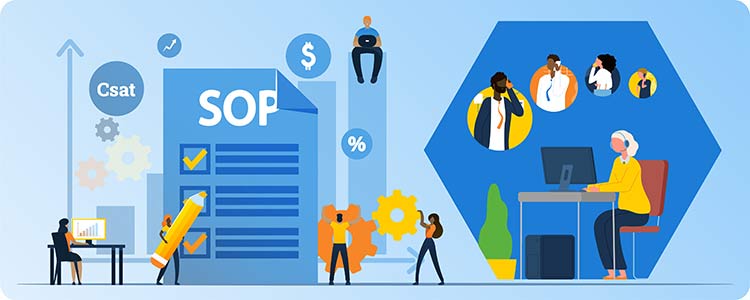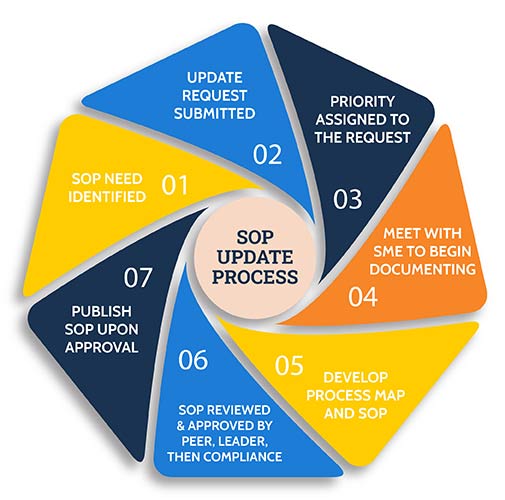Call Center Standard Operating Procedures
A standard operating procedure (SOP) is a set of step-by-step instructions compiled by an organization to help workers carry out routine operations. SOPs aim to achieve efficiency, quality output, and performance uniformity while reducing miscommunication and failure to comply with industry regulations.
Many call centers use SOPs to help them deliver First Call Resolution (FCR) and provide great customer service. In most cases, call center SOP practices are specific to their operation and describe the activities needed to complete a task in accordance with an organization’s standards for call handling specific inquiries and problems.
It has been SQM’s experience that most call centers have used SOP practices to varying degrees for a long time. However, call centers performing at high FCR and Customer Satisfaction (Csat) levels tend to be effective at SOP call handling practices for all their core call types and lines of business. In addition, SQM has many clients who have improved their FCR and Csat performance by improving their existing SOP practices.

The main reason why SOP practices are so effective for improving the FCR and Csat performance for resolving inquiries and problems on the first contact is because they are based on the most common contact reasons (e.g., billing, claims, orders, or account balance inquiry). In other words, when a call center has effective SOP practices for handling recurring types of inquiries or problems, they tend to have high FCR and Csat performance.
Self-service touchpoints are effective, for the most part, for handling repetitive low-complexity inquiries or problems; however, there is room for FCR and Csat improvement. Self-service touchpoints are more effective at repetitive contact handling than touchpoints serviced by agents, primarily because self-service is automated, provides consistent messaging, and is less complex.
Being human, agents are more inconsistent. The vast majority of calls that agents handle are repetitive types of contacts. This provides an excellent opportunity to improve FCR and Csat when an organization focuses on enhancing the SOP practices for these specific reoccurring contact types.
Again, it is easier to improve an inquiry or problem, in most cases, if it is a repetitive type of contact. When selecting employees to develop or revise SOPs, they must be familiar with the existing SOPs from both an organization’s and a customer’s perspective. The most effective SOP reviewers are analysts and subject matter experts (e.g., agents, supervisors, and QA evaluators).
Evaluating SOPs
Senior management needs to own the SOPs to evaluate and improve the SOP practice. Reviewers should evaluate SOPs for core reoccurring inquiries or problems for FCR and Csat effectiveness and consider the following:
- Is the content current and accurate?
- Are tasks and workflows efficient and effective?
- Are SOPs benchmarked against proven best practices?
- Are SOPs based on VoC or operational facts versus opinions?
- Is the wording or interpretation accurate?
Best Practices for Managing SOPs
The following are the best practices for managing the SOP process:
- Have a manager own the entire SOP practice and review SOP FCR effectiveness for critical inquiries and problems with senior management
- Set up a system to monitor core SOPs to ensure FCR. Request that agents, supervisors, and the marketing department report required changes needed to achieve FCR
- Assign approved SOP version numbers with a date stamp and use an SOP template. The template will help to ensure all SOP information is covered and is in a consistent format
- Many organizations use ISO 9000 as a business model for managing their SOPs. But unfortunately, SOP documentation is only as good if it helps improve or maintain high FCR
- The SOP needs to be well written to understand the SOPs. In addition, make sure that processes and procedures are adhered to
- When there are changes in your business (e.g., people, products, service, pricing, or policies), be aware of these changes, change SOPs, and check for FCR effectiveness
Genworth Call Center Documentation Process
Call center of the year and SOP best practices award-winning Genworth call center uses an effective documentation process to update SOPs. First, they assign a technical writer who meets with the Subject Matter Expert (SME) to gather all relevant information to document the process. Then, a process map is created and reviewed with the SME to ensure all steps are included.
Once the map is approved, the SOP is written. The SOP must go through several levels of approval, including Peer, QA, Leader, and Compliance, before being published and uploaded to the shared knowledge site. Agents can then access the SOP as needed to resolve calls and process transactions. In addition, a monthly newsletter is distributed throughout the organization to notify employees of new and updated SOPs and process improvements. See the below infographic for a visual model of the process.
SOP UPDATE PROCESS

Quick Related Links
First Call Resolution Definition First Call Resolution PPT First Call Resolution Benefits First Call Resolution Strategies First Call Resolution Operating Philosophy FCR Case Study Survey Data Call Handling Five Benefits of Journey Mapping CX Pulse Check Top 10 CX Metrics VoC Closed-Loop Journey Mapping FCR Strategy Options
